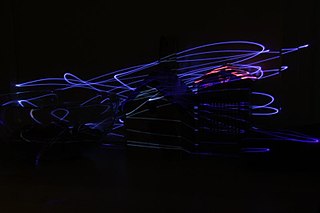 W
WBlu-ray Disc (BD), often known simply as Blu-ray, is a digital optical disc storage format. It is designed to supersede the DVD format, capable of storing several hours of video in high-definition. The main application of Blu-ray is as a medium for video material such as feature films and for the physical distribution of video games for the PlayStation 3, PlayStation 4, PlayStation 5, Xbox One and Xbox Series X. The name "Blu-ray" refers to the blue laser used to read the disc, which allows information to be stored at a greater density than is possible with the longer-wavelength red laser used for DVDs.
 W
WThis article compares the technical specifications of multiple high-definition formats, including HD DVD and Blu-ray Disc; two mutually incompatible, high-definition optical disc formats that, beginning in 2006, attempted to improve upon and eventually replace the DVD standard. The two formats remained in a format war until February 19, 2008, when Toshiba, HD DVD's creator, announced plans to cease development, manufacturing and marketing of HD DVD players and recorders.
 W
WUltra HD Blu-ray (UHD-BD) is a digital optical disc data storage format that is an enhanced variant of Blu-ray. Ultra HD Blu-ray discs are incompatible with existing standard Blu-ray players. Ultra HD Blu-ray supports 4K UHD video at frame rates up to 60 progressive frames per second, encoded using High Efficiency Video Coding. The discs support both high dynamic range by increasing the color depth to 10-bit per color and a greater color gamut than supported by conventional Blu-ray video by using the Rec. 2020 color space. It is supported on Microsoft's Xbox One X and One S; the Xbox Series X and also on Sony's PlayStation 5 video game consoles.
 W
W7.1 surround sound is the common name for an eight-channel surround audio system commonly used in home theatre configurations. It adds two additional speakers to the more conventional six-channel (5.1) audio configuration. As with 5.1 surround sound, 7.1 surround sound positional audio uses the standard front left and right, center, and LFE (subwoofer) speaker configuration. However, whereas a 5.1 surround sound system combines both surround and rear channel effects into two channels, a 7.1 surround system splits the surround and rear channel information into four distinct channels, in which sound effects are directed to left and right surround channels, plus two rear surround channels.
 W
WThe Advanced Access Content System (AACS) is a standard for content distribution and digital rights management, intended to restrict access to and copying of the post-DVD generation of optical discs. The specification was publicly released in April 2005 and the standard has been adopted as the access restriction scheme for HD DVD and Blu-ray Disc (BD). It is developed by AACS Licensing Administrator, LLC, a consortium that includes Disney, Intel, Microsoft, Panasonic, Warner Bros., IBM, Toshiba and Sony. AACS has been operating under an "interim agreement" since the final specification has not yet been finalized.
 W
WThe Blu-ray Disc Association (BDA) is the industry consortium that develops and licenses Blu-ray Disc technology and is responsible for establishing format standards and promoting business opportunities for Blu-ray Disc. The BDA is divided into three levels of membership: the Board of Directors, Contributors, and General Members.
Blu-ray Disc Recordable (BD-R) refers to two direct to disc optical disc recording technologies that can be recorded on to a Blu-ray-based optical disc with an optical disc recorder. BD-R discs can be written to once, whereas Blu-ray Disc Recordable Erasable (BD-RE) can be erased and re-recorded multiple times. Disc capacities are 25 GB for single-layer discs, 50 GB for double-layer discs, 100 GB ("XL") for triple-layer, and 128 GB for quadruple-layer.
 W
WA blue laser is a laser that emits electromagnetic radiation with a wavelength between 360 and 480 nanometers, which the human eye sees as blue or violet.
 W
WCinavia, originally called Verance Copy Management System for Audiovisual Content (VCMS/AV), is an analog watermarking and steganography system under development by Verance since 1999, and released in 2010. In conjunction with the existing Advanced Access Content System (AACS) digital rights management (DRM) inclusion of Cinavia watermarking detection support became mandatory for all consumer Blu-ray Disc players from 2012.
 W
WDTS-HD Master Audio is a combined lossless/lossy audio codec created by DTS, commonly used for surround-sound movie soundtracks on Blu-ray Disc.
 W
WHigh Fidelity Pure Audio, occasionally abbreviated as HFPA, is a marketing initiative, spearheaded by Sony Music Universal Music Group, for audio-only Blu-ray optical discs. Launched in 2013 as a potential successor to the compact disc (CD), it has been compared with DVD-Audio and SACD, which had similar aims.
 W
WThe high-definition optical disc format war was between the Blu-ray and HD DVD optical disc standards for storing high-definition video and audio; it took place between 2006 and 2008 and was won by Blu-ray Disc.
 W
WM-DISC is a write-once optical disc technology introduced in 2009 by Millenniata, Inc. and available as DVD and Blu-ray discs.
 W
WBlu-ray Disc (BD), often known simply as Blu-ray, is a digital optical disc storage format. It is designed to supersede the DVD format, capable of storing several hours of video in high-definition. The main application of Blu-ray is as a medium for video material such as feature films and for the physical distribution of video games for the PlayStation 3, PlayStation 4, PlayStation 5, Xbox One and Xbox Series X. The name "Blu-ray" refers to the blue laser used to read the disc, which allows information to be stored at a greater density than is possible with the longer-wavelength red laser used for DVDs.
 W
WPlayStation 3 (PS3) is a home video game console developed by Sony Computer Entertainment. It is the successor to PlayStation 2, and is part of the PlayStation brand of consoles. It was first released on November 11, 2006 in Japan, November 17, 2006 in North America, and March 23, 2007 in Europe and Australia. The PlayStation 3 competed primarily against Microsoft's Xbox 360 and Nintendo's Wii as part of the seventh generation of video game consoles.
 W
WThe Sony BDP-S1 is a first generation Blu-ray Disc (BD) player and is the first such player released in North America. It was originally scheduled for release in the United States on August 18, 2006 with a MSRP of $999.95. Sony had postponed the release date of this player several times and it was released on December 4, 2006.